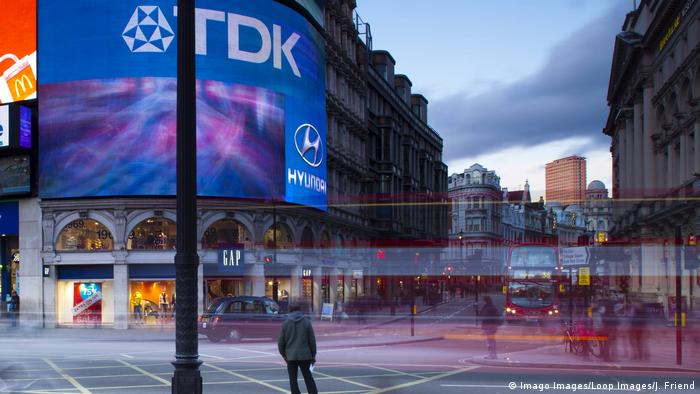US, Colombia vow to support effort to oust Venezuela's Maduro
US Secretary of State Mike Pompeo has said Washington plans to do more to support Venezuelan opposition leader Juan Guaido. Guaido, who was defying a travel plan to speak in Colombia, plans to travel on to Europe.

The United States and Colombia have vowed to do more to support Venezuelan opposition leader Juan Guaido and his efforts to remove President Nicolas Maduro.
"I would fully expect there will be further action that the United States would take to continue to support President Guaido and the Venezuelan people," said US Secretary of State Mike Pompeo at an anti-terrorism conference in Bogota on Monday. "We do not talk about particular sanctions but everyone can fully expect that the United States is not done."
Pompeo described Venezuela as a "failed state." Under Maduro's leadership, the South American country has suffered an economic collapse and hyperinflation since the start of 2016.
More than 4 million Venezuelans have fled the country, many to Colombia, a choice which Pompeo blamed on the policies of Maduro's "terror regime." He added that Maduro was now "working alongside terror organizations inside of his own country."
Read more: Opinion: Latin America's upheaval tips toward chaos
Guaido on tour
Pompeo appeared at a regional conference along with Guaido, who had arrived in Colombia on Sunday to meet with President Ivan Duque despite a court-imposed travel ban. He has only traveled outside Venezuela one other time in the last year, sneaking across the border into Colombia to oversee a failed bid to bring in humanitarian aid in February 2019.
"We are honored by your presence,'' Duque told Guaido. "You will always have a friend in Colombia."
Guaido has been recognized by around 50 nations as Venezuela's interim president. On Monday, Guaido said Maduro's "brutal" dictatorship put opponents "at the risk of being jailed or killed."
Read more: Venezuela's love-hate relationship with the US dollar
Maduro was reelected in 2018 in a vote boycotted by many opposition parties, citing perceived irregularities in what commentators described as a "show election."

VENEZUELANS FIND REFUGE, SOLIDARITY IN COLOMBIA
Waiting in line
Venezuelan migrants wait in line to have their registration number and details checked before receiving their lunch. The UN's World Food Program serves food three times a day.
MORE PHOTOS
12345678910
ed/cmk (AFP, Reuters, dpa)
DW RECOMMENDS
Venezuela and Colombia border tension fuels fear of armed conflict
A large-scale military exercise and the invoking of a regional defense pact have Venezuela and Colombia on edge. How likely is a military confrontation between the South American neighbors? (17.09.2019)
Peru hotel welcomes Venezuela's refugees
Some 715,000 Venezuelans now live in Peru, and almost all of them arrived through the border town of Tumbes. Here, a compassionate hotel manager is providing refugees with a roof over their heads. Oliver Pieper reports. (07.04.2019)
Venezuelans find refuge, solidarity in Colombia
Colombia's Maicao is infamous for its drug and people smuggling, violence and sexual exploitation. Venezuelan refugees living on the streets are an easy target. But a UNHCR-run reception center is offering a way out. (13.07.2019)
AUDIOS AND VIDEOS ON THE TOPIC
Venezuela's families are starving
Hyperinflation cripples Venezuela's economy
South American countries are suffering through terrible economies
Date 20.01.2020
Related Subjects Venezuela
Keywords Colombia, Venezuela, Mike Pompeo, Juan Guaido, Nicolas Maduro
Feedback: Send us your feedback.
Print Print this page
Permalink https://p.dw.com/p/3WWBN
RELATED CONTENT

Venezuela opposition denounces 'parliamentary coup' 05.01.2020
Opposition leader Juan Guaido and rival lawmaker Luis Parra are both claiming to be the next head of the National Assembly. Guaido, barred from entering congress, had a heated exchange with security forces.

Venezuela's opposition leader Guaido sits at contested parliamentary speaker chair 07.01.2020
Venezuelan opposition leader Juan Guaido and a former ally have staked rival claims to the parliamentary speaker post. The National Assembly is the sole institution outside the hands of President Maduro's Socialists.

Venezuela: Opposition lawmakers to be tried for treason 16.12.2019
Self-proclaimed interim president Juan Guaido said the trial was another attempt by Nicolas Maduro to take over the opposition-led legislature. The move comes as the opposition has been weakened by corruption scandals.
US Secretary of State Mike Pompeo has said Washington plans to do more to support Venezuelan opposition leader Juan Guaido. Guaido, who was defying a travel plan to speak in Colombia, plans to travel on to Europe.

The United States and Colombia have vowed to do more to support Venezuelan opposition leader Juan Guaido and his efforts to remove President Nicolas Maduro.
"I would fully expect there will be further action that the United States would take to continue to support President Guaido and the Venezuelan people," said US Secretary of State Mike Pompeo at an anti-terrorism conference in Bogota on Monday. "We do not talk about particular sanctions but everyone can fully expect that the United States is not done."
Pompeo described Venezuela as a "failed state." Under Maduro's leadership, the South American country has suffered an economic collapse and hyperinflation since the start of 2016.
More than 4 million Venezuelans have fled the country, many to Colombia, a choice which Pompeo blamed on the policies of Maduro's "terror regime." He added that Maduro was now "working alongside terror organizations inside of his own country."
Read more: Opinion: Latin America's upheaval tips toward chaos
Guaido on tour
Pompeo appeared at a regional conference along with Guaido, who had arrived in Colombia on Sunday to meet with President Ivan Duque despite a court-imposed travel ban. He has only traveled outside Venezuela one other time in the last year, sneaking across the border into Colombia to oversee a failed bid to bring in humanitarian aid in February 2019.
"We are honored by your presence,'' Duque told Guaido. "You will always have a friend in Colombia."
Guaido has been recognized by around 50 nations as Venezuela's interim president. On Monday, Guaido said Maduro's "brutal" dictatorship put opponents "at the risk of being jailed or killed."
Read more: Venezuela's love-hate relationship with the US dollar
Maduro was reelected in 2018 in a vote boycotted by many opposition parties, citing perceived irregularities in what commentators described as a "show election."

VENEZUELANS FIND REFUGE, SOLIDARITY IN COLOMBIA
Waiting in line
Venezuelan migrants wait in line to have their registration number and details checked before receiving their lunch. The UN's World Food Program serves food three times a day.
MORE PHOTOS
12345678910
ed/cmk (AFP, Reuters, dpa)
DW RECOMMENDS
Venezuela and Colombia border tension fuels fear of armed conflict
A large-scale military exercise and the invoking of a regional defense pact have Venezuela and Colombia on edge. How likely is a military confrontation between the South American neighbors? (17.09.2019)
Peru hotel welcomes Venezuela's refugees
Some 715,000 Venezuelans now live in Peru, and almost all of them arrived through the border town of Tumbes. Here, a compassionate hotel manager is providing refugees with a roof over their heads. Oliver Pieper reports. (07.04.2019)
Venezuelans find refuge, solidarity in Colombia
Colombia's Maicao is infamous for its drug and people smuggling, violence and sexual exploitation. Venezuelan refugees living on the streets are an easy target. But a UNHCR-run reception center is offering a way out. (13.07.2019)
AUDIOS AND VIDEOS ON THE TOPIC
Venezuela's families are starving
Hyperinflation cripples Venezuela's economy
South American countries are suffering through terrible economies
Date 20.01.2020
Related Subjects Venezuela
Keywords Colombia, Venezuela, Mike Pompeo, Juan Guaido, Nicolas Maduro
Feedback: Send us your feedback.
Print Print this page
Permalink https://p.dw.com/p/3WWBN
RELATED CONTENT

Venezuela opposition denounces 'parliamentary coup' 05.01.2020
Opposition leader Juan Guaido and rival lawmaker Luis Parra are both claiming to be the next head of the National Assembly. Guaido, barred from entering congress, had a heated exchange with security forces.

Venezuela's opposition leader Guaido sits at contested parliamentary speaker chair 07.01.2020
Venezuelan opposition leader Juan Guaido and a former ally have staked rival claims to the parliamentary speaker post. The National Assembly is the sole institution outside the hands of President Maduro's Socialists.

Venezuela: Opposition lawmakers to be tried for treason 16.12.2019
Self-proclaimed interim president Juan Guaido said the trial was another attempt by Nicolas Maduro to take over the opposition-led legislature. The move comes as the opposition has been weakened by corruption scandals.























